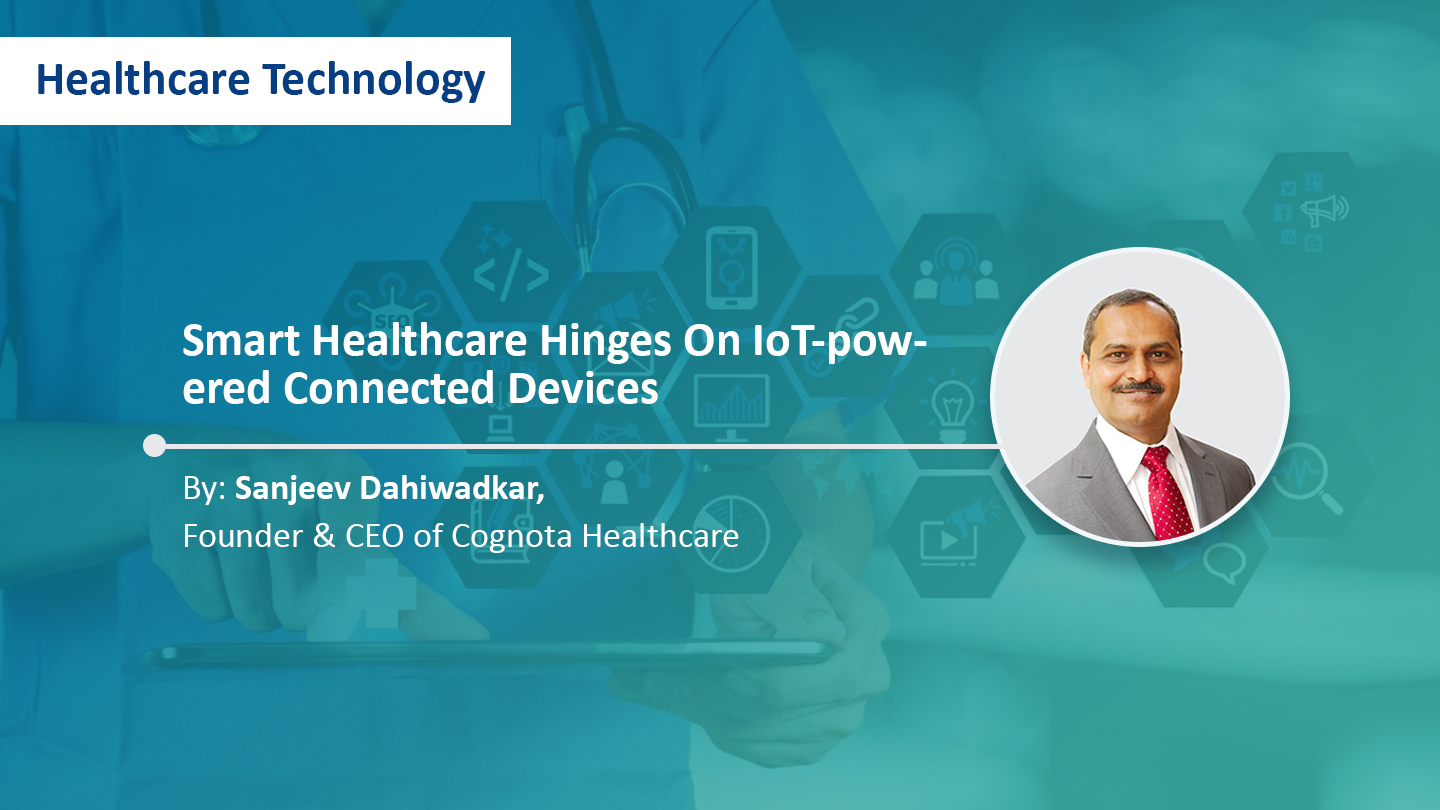
By: Sanjeev Dahiwadkar
Founder & CEO of @CognotaHealthcare
The ongoing COVID pandemic has accelerated the pace of digital adoption among both healthcare providers and patients. Against this backdrop, smart hospital as a concept has grown in prominence. Smart hospitals leverage advanced analytics, connected devices, and healthtech platforms for delivering efficient patient care while minimizing risks to nurses and doctors. Especially, connected devices powered through digital technologies such as the Internet of Things (IoT), data analytics and Artificial Intelligence (AI) are witnessing rising adoption. No wonder, healthcare devices represent one of the fastest-growing sectors of the IoT market. According to global market research firm ‘MarketsandMarkets’, the global IoT medical devices market is projected to reach US$94.2 billion by 2026 from US$ 26.5 billion in 2021, at a CAGR of 28.9 per cent during this five-year period. IoTs are enabling better service while reducing direct contacts with patients. This is best balanced solution for the patients and the providers (nurses and doctors).
Cost advantage, scarce healthcare professionals drive the trend:
The global healthcare system was overwhelmed during the peak period of COVID infections. An inadequate number of healthcare professionals was the main factor behind the lack of timely interventions for critical patients. According to the World Health Statistics report 2017, around 40 per cent of countries have less than one physician per 1,000 people and less than 18 hospital beds per 10,000 people. In emerging economies like India, the ratio is far worse. Every allopathic doctor in India provides healthcare to at least 1,511 people, much higher than the World Health Organization’s norm of one doctor for every 1,000 people. The shortage of trained nurses is even worse with a nurse-to-population ratio of 1:670 against the WHO norm of 1:300. Connected devices, therefore, can take out much of the workload of healthcare professionals through intelligent automation. Emerging economies in Asia and Africa can enable their healthcare system for optimum efficiency through IoT-powered connected healthcare devices.
Rising healthcare cost is a cause of concern globally. Historically, technology reduces the cost of operations. So, hospitals are increasingly going digital not only to deliver better healthcare services but also to deliver those at low cost. Not only private healthcare providers, even governments across the globe are also adopting digital platforms to deliver healthcare at scale. Indian government’s National Digital Health Mission is a good example of enabling better patient care by having access to patients’ medical history. Vaccination records are just a start of this new direction of healthcare industry.
Varied use cases with multiple applications:
Connected healthcare devices are being used in multiple areas of patient care. Remote Patient Monitoring (RPM) is the most significant use case of these devices wherein IoT-powered software applications are successfully embedded within hardware devices to automatically collect health metrics like heart rate, blood pressure, temperature, and more such critical data points from patients without any physical interventions. After the IoT device collects patient data, it forwards those data to the healthcare providers’ IT system. Healthcare providers can access those in one dashboard and make timely interventions. Alerts can also be generated with the help of algorithms that generate patterns for initiating action. This proactive approach to treatment is saving lot of health complications and patients are getting better treatment sooner.
Apart from RPM, IoT-powered healthcare devices are also being used for glucose monitoring, hand hygiene monitoring, heart-rate monitoring, and many more. Depression and mood monitoring, which has usually been difficult to diagnose, is also being gauged through heart rate and blood pressure collected through Mood-aware IoT devices. Eventually, entire human body can be monitored by various means.
Robotic surgery is another growing area in the connected devices space. Surgeries performed through small IoT devices perform surgeries with precision with less invasive processes.
Cognota Healthcare is leveraging various emerging technologies for developing cutting-edge healthtech solutions. It has integrated Internet of Things (IoT)-powered software solution with hardware devices to develop its unique Remote Patient Monitoring (RPM) platform ‘Cognota Command Center’. The interface collects data from multiple specialty medical devices functioning in ICU (intensive care unit) and ward in a secured cloud environment and sends hemodynamic vital signs of patients collected from those devices to the hospital’s information system on a real-time basis. Such critical inputs can be accessed by medical staff on any device remotely enabling them to make effective care decisions. The solution comes with easy-to-integrate APIs that function seamlessly with the hospital’s existing information system with no latency.
Security aspect is critical:
While IoT-powered devices are transforming digital healthcare, cyber threats pose real risks to the connected devices ecosystem. The failure to effectively secure the devices can result in the theft of patient data. This will jeopardize the safety and security of the patient. Also, potential reputational and compliance risks will arise leading to a regulatory penalty. In this perspective, healthcare organisations have to operate these devices in a secured cloud- public or private- environment with utmost emphasis on data security. Collaboration with a healthtech company with a proven track record and project implementation experience, therefore, will go a long way in receiving the desired outcome.
Tags
- Smart hospitals
- smart healthcare
- connected devices
- IoT
- IoT devices
- RPM
- National Digital Health Mission
- WHO
- AI
- healthtech solutions
- patient-to-doctor ratio


